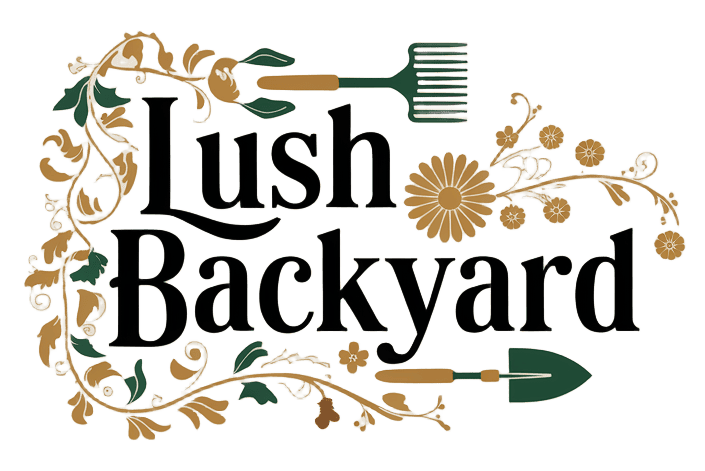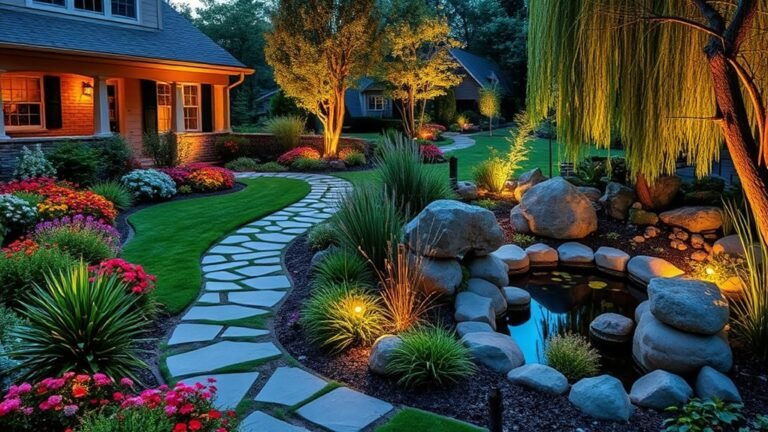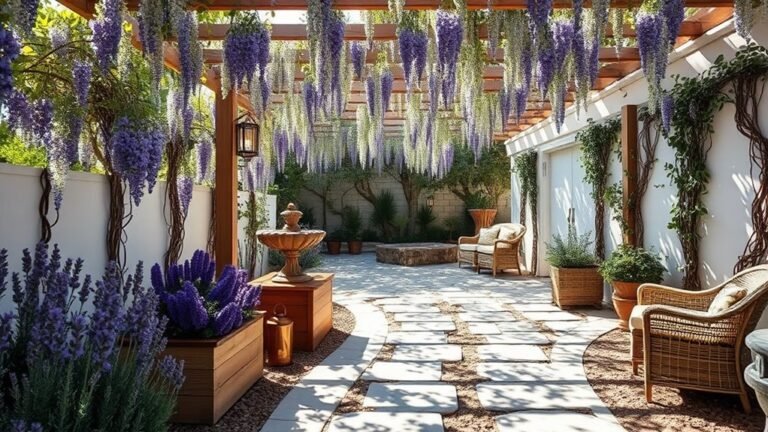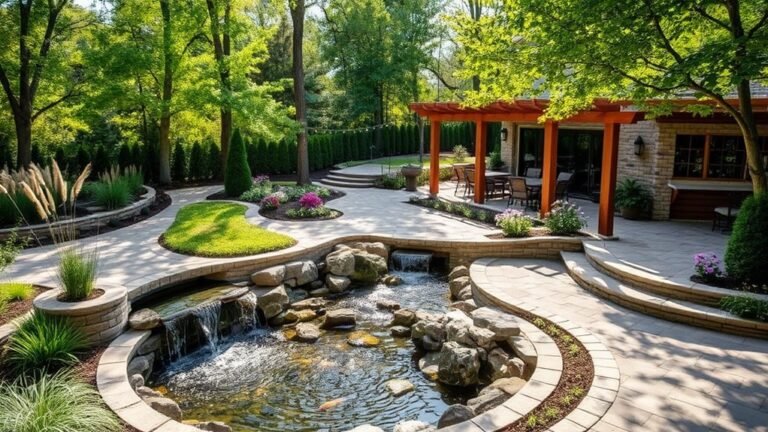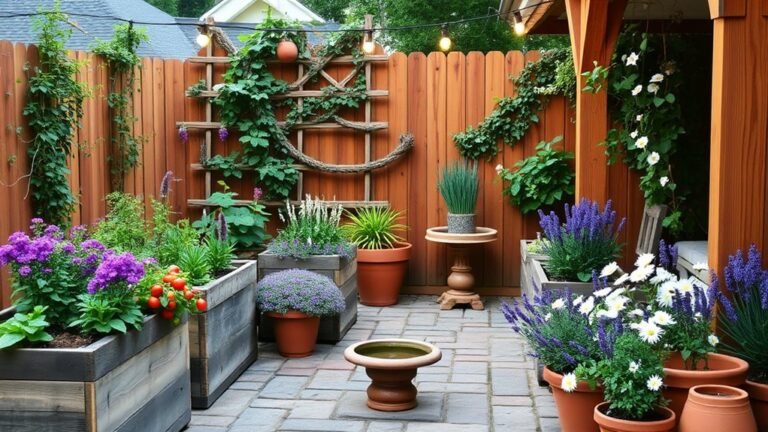22 Backyard Raised Bed Garden Ideas for Easy Planting
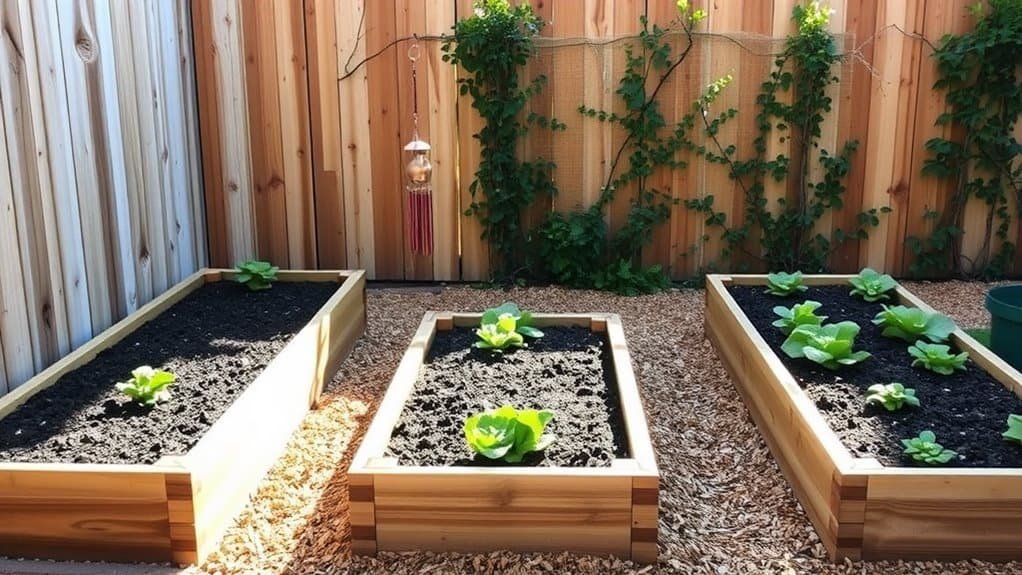
Raised bed gardening enhances plant health by improving drainage and soil quality. With 22 unique backyard raised bed garden ideas, you'll discover designs that simplify planting and beautify your outdoor space.
From stackable beds to vertical solutions, there's an ideal option for every gardener. Explore these concepts to see how they can transform your garden into a thriving oasis.
Classic Wooden Raised Beds

Classic wooden raised beds add timeless charm to any backyard garden, creating a functional space for plants while minimizing the need to bend over.
Imagine cultivating rich soil, surrounded by vibrant blooms and fresh vegetables—all while standing comfortably.
Building your own raised beds can be enjoyable and allows for customization in size, height, and wood type.
Cedar is ideal for its decay resistance, while treated lumber offers durability. Plus, you can proudly share that you crafted it yourself!
Once set up, planting is easier thanks to improved drainage and soil quality, promoting healthy growth.
Whether you're growing juicy tomatoes or colorful flowers, these classic wooden raised beds will enhance your garden experience.
Consider the importance of proper drainage to prevent rust and warping of tools and walls, ensuring long-lasting use of your raised beds.
You'll relish the joy and satisfaction they provide. Happy gardening!
Stackable Garden Beds
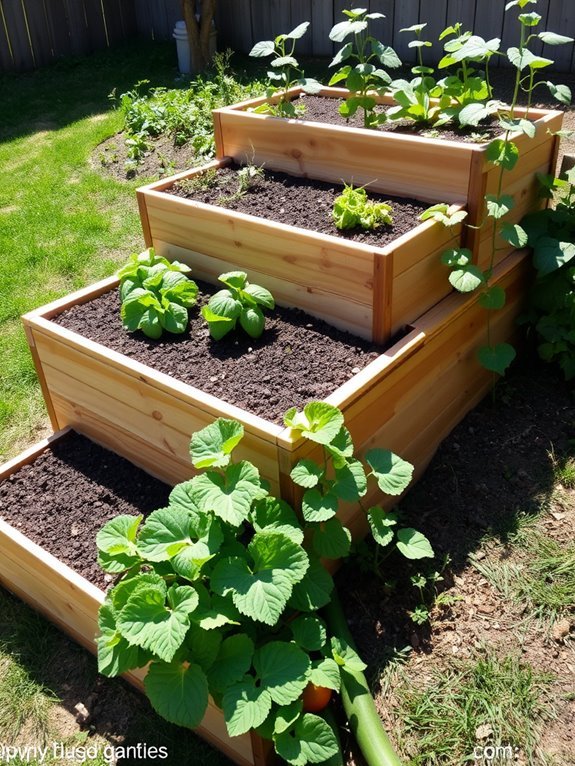
Stackable garden beds maximize gardening space, perfect for small backyards or urban settings. They allow you to layer plants without requiring a large area, offering customizable height and designs suited to your preferences.
Here are three effective ways to utilize stackable garden beds:
- Layered Planting: Use shallow-root plants for the top tier and deep-rooted ones below to create a mini ecosystem.
- Seasonal Rotation: Easily rotate crops by changing the top layer with seasonal flowers or herbs for a fresh garden look.
- Mix Materials: Get creative with wood, metal, or recycled containers to add character and explore different textures and colors.
Embrace your inner architect and transform your stackable garden beds into a stunning vertical paradise, making gardening even more enjoyable!
Vertical Garden Solutions

To maximize limited space, consider vertical garden solutions that beautifully complement your stackable beds. These setups turn gardening into a fun puzzle, offering options like wall-mounted planters, trellises, and hanging plant pockets.
Imagine herbs cascading down a trellis or vibrant blooms spilling over wall-mounted shelves. Vertical gardens save space while providing a stunning visual display that will have your neighbors peeking over the fence in envy!
You can even repurpose items like old pallets or crates, making gardening a fantastic upcycling project.
Start by selecting plants that thrive in vertical spaces, such as climbing beans, tomatoes, or strawberries. Don't forget succulents for their unique flair and minimal care.
Keep sunlight requirements in mind to ensure your plants receive adequate light. With creativity and enthusiasm, transform your garden into a thriving vertical oasis, yielding fresh produce and blooming joy without occupying valuable ground space!
Incorporating Edible Flowers
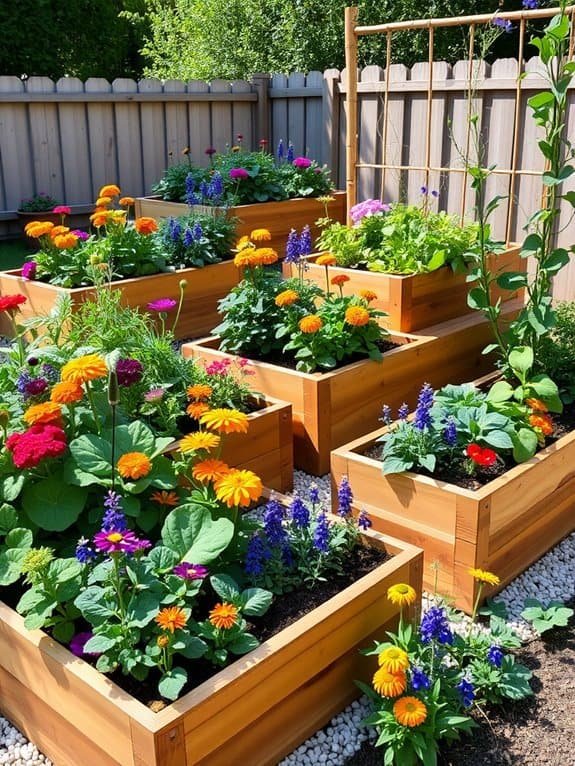
Have you thought about brightening your raised bed garden with edible flowers?
These lovely blooms not only enhance your salads but also attract beneficial pollinators like bees and butterflies.
Here are three fabulous options to consider:
- Nasturtiums: These vibrant, peppery flowers add color to salads and help divert aphids from other plants.
- Calendula: With its bright orange or yellow petals, calendula offers a subtle tang that enhances soups and stews.
- Pansies: Available in various colors, these charming flowers add visual interest and have a mild, sweet flavor, perfect for garnishing dishes.
Herb Spiral Design
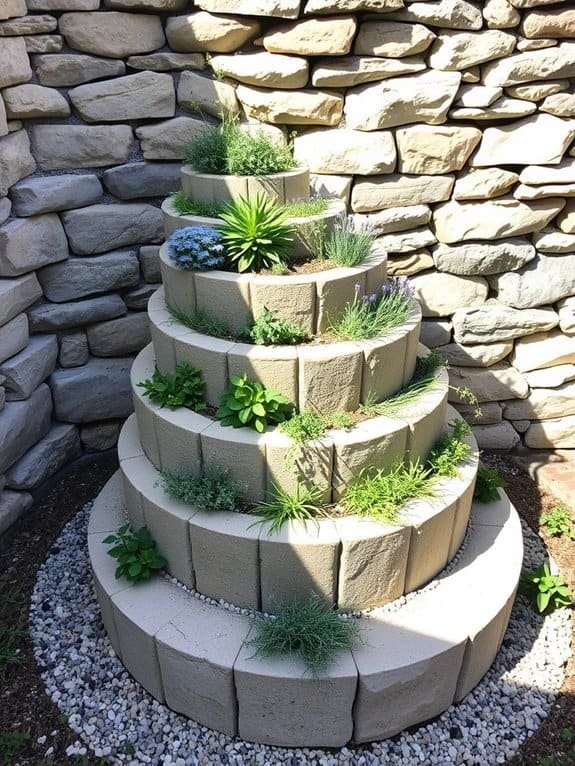
An herb spiral design maximizes garden space and enhances the aesthetics of raised beds. Picture a twisting structure that spirals upwards, creating diverse microclimates for your herbs—like vacation spots for plants!
Begin by gathering stones or bricks to form a circular base. Build upwards in a spiral shape, allowing taller herbs like basil to enjoy sunlight, while shade-loving varieties like mint thrive at the cooler base. This design merges practicality with creativity—who knew gardening could be so artistic?
When selecting herbs, think about your cooking preferences. Include rosemary and thyme for savory dishes or add chives and parsley for extra flavor.
Each layer expands your herb variety without taking up much space, making it a perfect conversation starter!
Raised Beds With Trellises
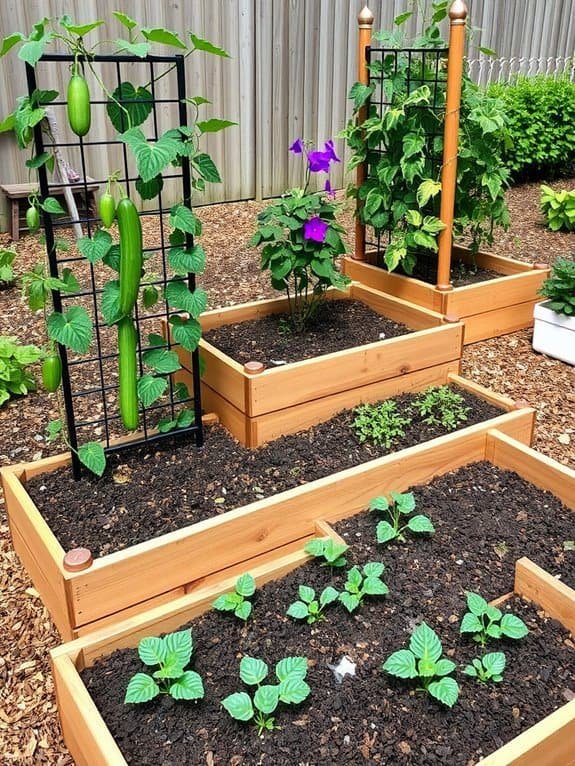
Raised beds with trellises save space while adding vertical interest to your garden.
Imagine vibrant vines climbing a trellis, transforming your backyard into a fairy tale scene! By integrating trellises, you can maximize planting area and enhance visuals.
Plus, climbing plants will thrive!
Here are three key benefits of raised beds with trellises:
- Space Efficiency: Grow more plants in a smaller area—perfect for urban gardens or compact backyards!
- Healthy Plants: Sunlight reaches every leaf, promoting better growth and yield. Who wouldn't want more tomatoes?
- Pest Management: Elevating crops with trellises helps keep pests at bay, protecting your hard work.
Pallet Garden Ideas
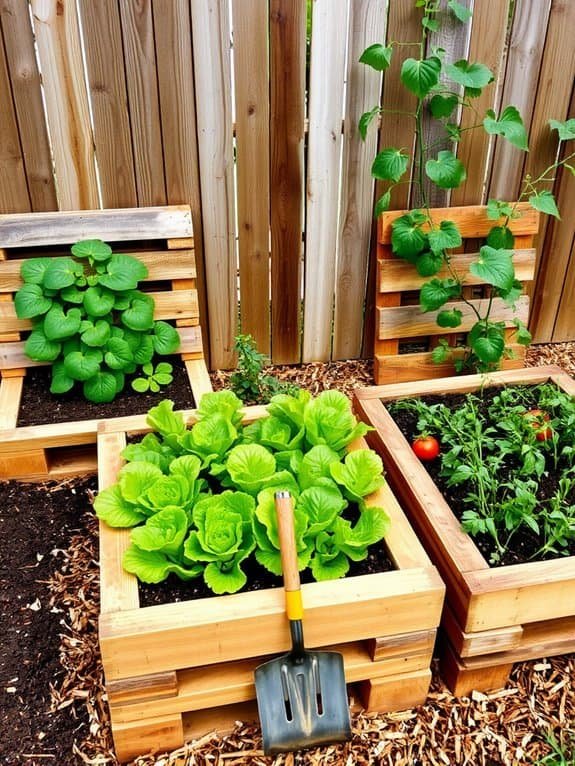
Transform your outdoor space with pallet gardens, an innovative way to repurpose materials while growing plants. Pallets are sturdy and versatile, perfect for creating vertical gardens that save space and add rustic charm to your yard.
To start, lay a pallet flat, fill it with soil, and plant herbs or veggies, ensuring proper drainage to prevent soggy roots.
For a creative touch, lean a pallet against a wall to create a vertical display by attaching pots or grow bags, creating a layered effect that will impress your neighbors.
Think of it as giving those forgotten pallets a garden makeover—like a DIY spa day!
With a splash of creativity, paint the pallets in vibrant colors or add decorations to personalize them.
Container Mixed With Raised Beds
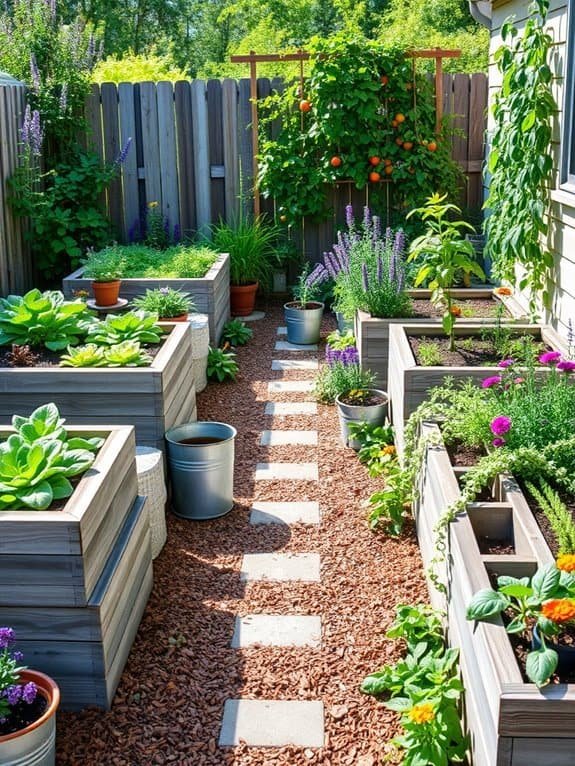
To maximize your gardening space, combine container planting with raised beds. This strategy enhances visual appeal and leverages the benefits of containers, such as mobility and varied growing conditions—no digging required!
Here are three ideas to get started:
- Vertical Containers: Use stacked pots or shelving to create vertical elements, bringing plants closer to eye level for easier care and enjoyment.
- Interplanting: Grow taller crops, like tomatoes, in raised beds while using containers for smaller plants such as herbs and salad greens to optimize space.
- Seasonal Rotation: Maximize your harvest by growing cool-weather vegetables in containers during spring and swapping them for summer crops as temperatures rise.
Elevated Planters for Accessibility
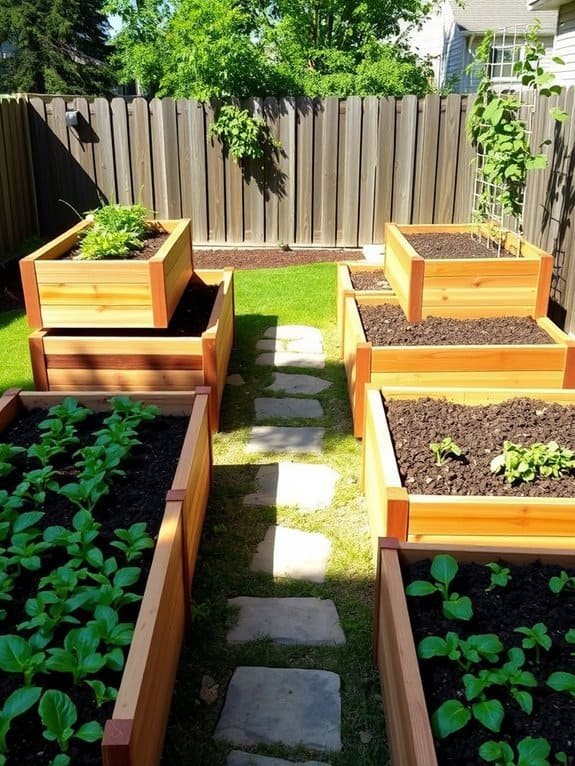
Elevated planters make gardening accessible for everyone, particularly those with limited mobility, by raising plants to an easy-to-reach height, eliminating the need to bend or kneel.
Picture tending to your vibrant veggies while sitting on a stool or in a wheelchair!
Crafted from wood, metal, or repurposed materials, these planters not only add unique charm to your garden but also help keep pests at bay.
Furthermore, the soil in elevated planters warms up faster in spring, giving your plants an early advantage.
For easy watering, consider adding a drip irrigation system or keeping a watering can nearby.
Gardening should be enjoyable, so incorporate colorful flowers and select plants that excite you!
Elevate your planting game and relish the fruits (and veggies!) of your labor.
The sky's the limit!
Circular Raised Bed Designs
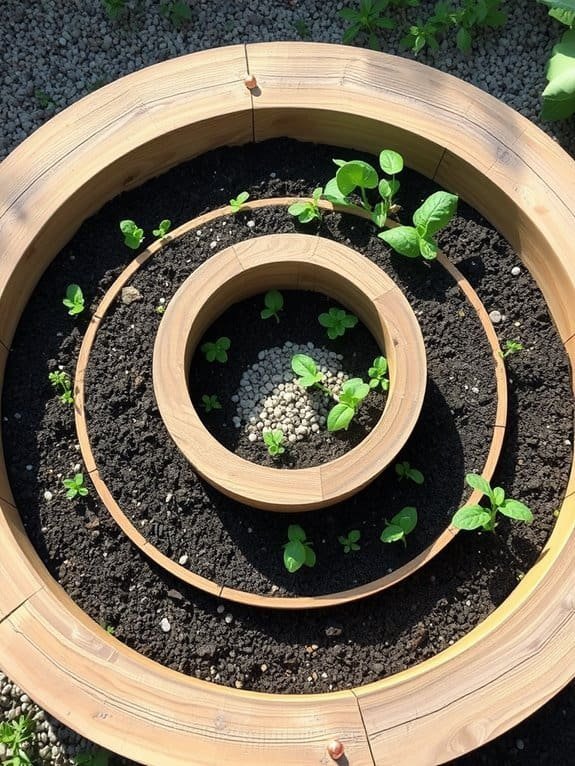
Circular raised bed designs add a fresh, dynamic touch to any garden while maximizing planting area for both functionality and aesthetics.
They're easy to maintain and encourage healthy plant growth.
Here are three key benefits of circular raised beds:
- Space Efficiency: Circular beds maximize planting area in a compact space, allowing for more veggies or flowers around the garden's edges.
- Accessibility: With a 360-degree view, you can reach every plant easily, ensuring a comfortable gardening experience.
- Soil Health: The circular shape promotes improved drainage and soil aeration, benefiting your plants as they absorb sunlight and nutrients.
You can also customize the size to suit your yard's unique shape.
Embrace circular raised bed designs; they offer both style and flourishing plants!
Reclaimed Material Raised Beds

Creating raised beds from reclaimed materials is an eco-friendly, budget-friendly way to enhance your garden. Repurpose old wood from fences or forgotten pallets into charming, rustic beds, adding a unique flair that store-bought options can't match!
Collect materials like wooden crates, bricks, or even old bathtubs, ensuring they're safe for gardening by checking for harmful chemicals in treated wood. Use your creativity to assemble your raised bed—consider adding broken tile mosaics for a whimsical touch!
Building these beds can become a fun family project, allowing kids to get involved while creating something beautiful.
Plus, your quirky new garden beds will spark conversations with neighbors. Roll up your sleeves, embrace your inner DIY enthusiast, and enjoy the process of adding sustainability to your backyard!
Painted and Decorative Beds

Transform your backyard with painted and decorative raised beds to add vibrant color and personality to your garden. A simple wooden box can become a statement piece with a little creativity.
Here are three fun ideas to inspire you:
- Colorful Palettes: Use bright, contrasting colors that reflect your personality, like hot pinks, sunny yellows, or calming blues. Multiple colors on one bed can create a festive feel!
- Chalkboard Paint: Paint one side of your raised bed with chalkboard paint to write plant names, garden goals, or doodle favorite quotes—adding whimsy to your gardening routine.
- Stenciled Designs: Incorporate stencils to create beautiful patterns or designs, such as flowers or geometric shapes, showcasing your artistic flair!
Small Space Raised Beds
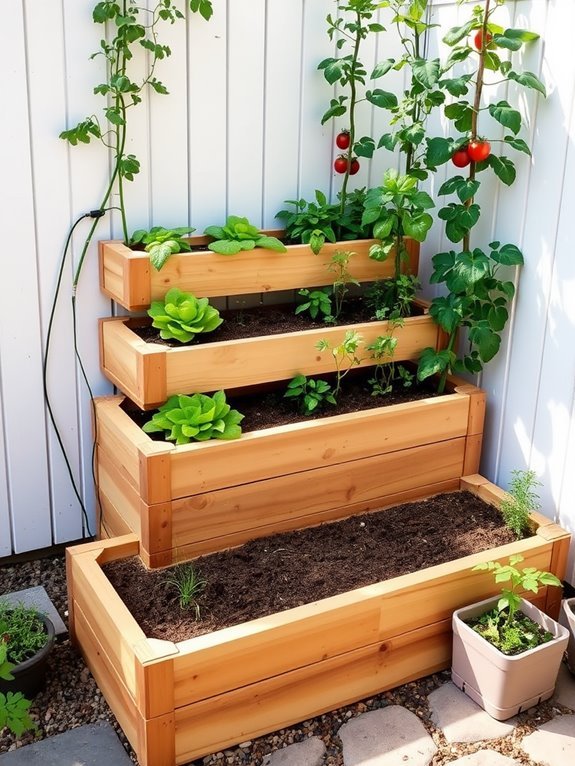
Maximize your gardening potential in tight spaces with small raised beds that perfectly fit your backyard. These space-savers are a game-changer for your gardening experience, allowing you to create a mini vegetable patch or a vibrant flower garden right outside your door.
Picture stepping out to grab fresh ingredients for dinner or enjoying blooms with your morning coffee. Small raised beds enable you to cultivate your favorite plants without extensive land requirements. They can be built from wood, bricks, or repurposed materials and come in various sizes—perfect for that little corner of your yard.
Don't underestimate their power! Compact spaces can yield big delights. With careful planning, you can enhance growth through companion planting and maximize sunlight absorption.
Plus, maintaining these beds is easy, allowing you to tend to your plants without straining your back. So roll up your sleeves, get planting, and watch your small raised beds flourish!
Rainbow Garden Layout

To brighten your garden, consider a vibrant rainbow layout that infuses your backyard with color and joy.
Here are three simple steps to create this lively space:
- Choose Your Plants: Select flowers and vegetables in reds, oranges, yellows, greens, blues, and purples, like zinnias, marigolds, sunflowers, and bright bell peppers for a varied splash of color.
- Layering Directions: Place taller plants in the back and gradually move to shorter ones in the front to maintain visibility and create a beautiful visual effect.
- Maintain Colorful Groups: Cluster plants in groups of three or five to enhance the color impact, transforming your garden into a vibrant scene.
Raised Beds With Pathways

Creating raised beds with pathways enhances your garden's organization, accessibility, and visual appeal. Imagine strolling through vibrant plants with clear paths guiding you!
Thoughtful planning allows for easy movement between beds. Use materials like gravel, mulch, or wood chips for your pathways, providing a lovely contrast to lush beds and comfort for your feet after digging.
Get creative with your design—curvy pathways add whimsy, while straight lines lend structure. Picture your garden as a well-organized library of plant delights!
Consider accessibility; wide paths accommodate garden carts and allow kids to help without damaging seedlings.
Lay out those paths and watch your backyard transform into a cozy, inviting sanctuary! Happy gardening!
Wildlife-Friendly Gardens

Incorporating pathways in your raised bed garden enhances accessibility and creates an inviting habitat for local wildlife, allowing you to enjoy the beauty and biodiversity right in your backyard.
Imagine the delight of watching butterflies flutter and birds chirp as they explore!
Here are three simple ways to make your garden wildlife-friendly:
- Plant Native Species: Select flowers and shrubs native to your area, which provide food and shelter for local creatures, turning your garden into their favorite spot.
- Add Water Sources: A shallow dish or small fountain can attract birds and beneficial insects, giving you a chance to see birds splashing around while you enjoy your morning coffee!
- Create Shelter Areas: Use brush piles or stone nooks to offer cozy hideaways for small animals and beneficial bugs, adding charm to your garden.
Embrace the joy of sharing your garden with nature as it transforms into a vibrant, life-filled ecosystem!
Raised Beds With Irrigation
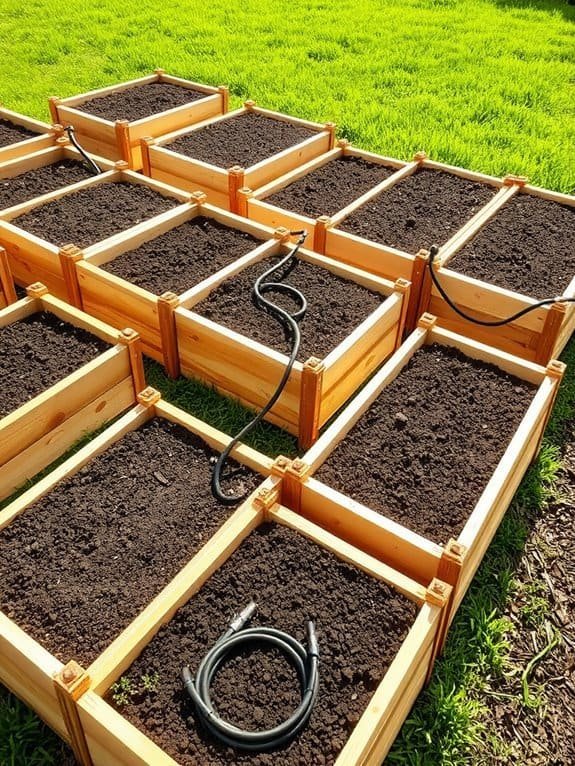
Enhance your raised bed garden with an irrigation system for a more efficient gardening experience.
Imagine waking up to sunshine and just flipping a switch instead of dragging a heavy hose! Drip irrigation or soaker hoses not only save time but also provide water directly to the roots, promoting healthier plants and minimizing water waste.
Installing a simple irrigation system with affordable materials is easy. Drip lines deliver targeted hydration, and you can even set it on a timer—watering your garden while you enjoy your coffee.
This system ensures consistent moisture levels, reducing the risk of under or over-watering, allowing your plants to thrive.
With thoughtful planning and a bit of creativity, your raised bed garden will flourish, giving you more time to enjoy your green oasis!
DIY Concrete Block Beds

If you're seeking a sturdy and stylish addition to your garden, DIY concrete block beds are a perfect choice. They provide a modern aesthetic while being practical, and you'll feel accomplished when you see the results!
Here's how to create your concrete block garden:
- Select the location: Pick a sunny area in your yard for optimal plant growth—veggies thrive in sunlight!
- Build the frame: Stack concrete blocks into a square or rectangle, just like giant Lego bricks. Ensure they're level for a tidy appearance.
- Fill with soil: Use high-quality potting mix to provide essential nutrients, and consider mixing in compost for an extra boost—your plants will appreciate it!
With some effort and creativity, your concrete block beds will become a neighborhood highlight!
Happy gardening!
Family-Friendly Gardening Areas
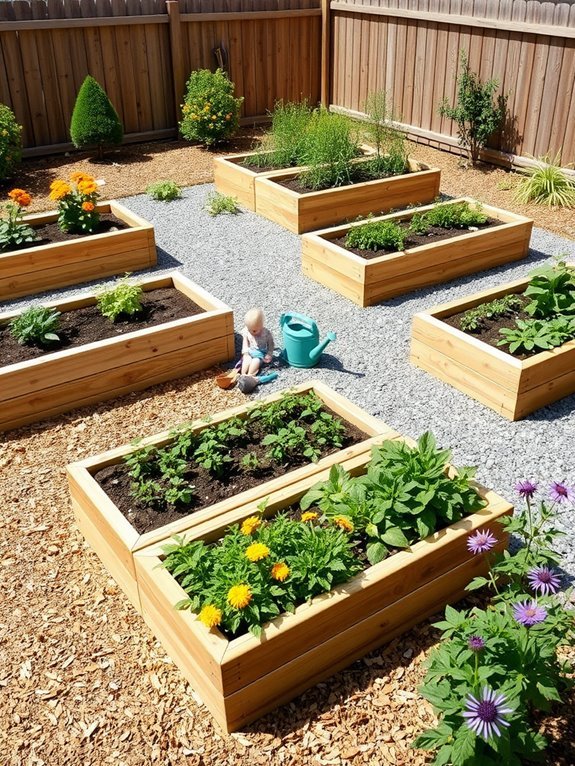
Transform your backyard into a family-friendly gardening area where both kids and adults can enjoy nature together. Imagine your little ones happily digging in the soil and creating unforgettable memories without needing a green thumb.
Start with accessible raised beds that are short and wide, allowing tiny hands to reach every corner. Plant colorful flowers alongside easy-to-grow veggies like carrots and radishes to spark kids' excitement as they watch their plants sprout.
Incorporate playful elements like garden signs or painted rocks to encourage creativity. Set up a mini compost area for a hands-on science lesson, and create a designated space for family activities, such as picnics or nature crafts, to bring everyone together.
Companion Planting Layout

Creating a family-friendly garden is a great way to engage kids and explore companion planting.
This gardening technique pairs plants that thrive together, enhancing growth and deterring pests, while providing a fun learning experience about nature!
Here are three excellent companion planting pairs to consider:
- Tomatoes and Basil: Basil boosts the flavor of tomatoes and repels insects like aphids.
- Carrots and Onions: Onions deter carrot flies, while carrots aerate the soil for onions.
- Beans and Corn: Beans enrich the soil with nitrogen, benefiting corn, and they climb the corn stalks for support—true teamwork!
Seasonal Rotation Strategy
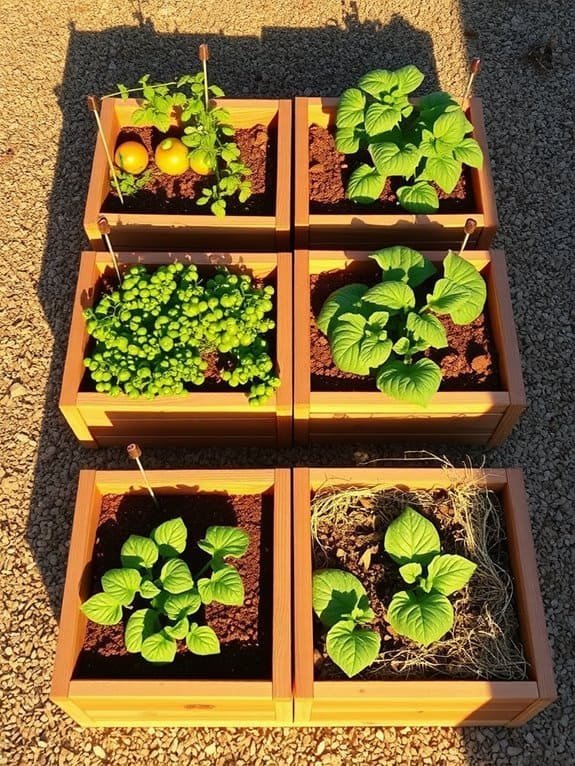
As seasons change, so should your garden's layout and plant selection to maximize yield and promote soil health. Crop rotation helps reduce pest buildup and maintains soil vitality by moving crops around each season.
Begin with cool-season crops like lettuce or peas in early spring, then transition to warm-season plants such as tomatoes and peppers as temperatures rise. In the fall, plant root vegetables like carrots and beets for a late harvest. This variety will benefit your soil and result in a healthier garden.
Keep it simple: avoid planting the same crop family in the same spot for at least two years.
Consider maintaining a garden journal to track your planting schedule and locations. Embrace variety, and your garden will thrive! Happy planting!
Integrating Fencing and Support
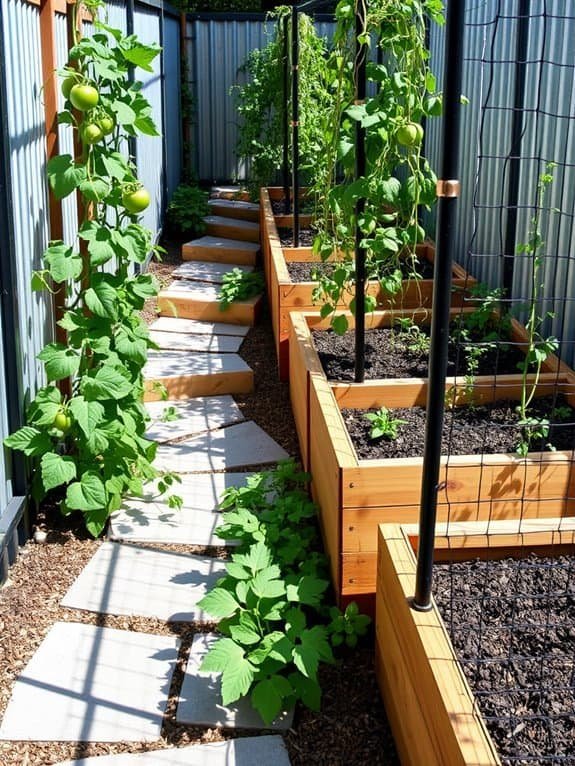
When planning your backyard raised bed garden, integrating fencing and support structures can significantly boost plant growth and security. Fencing wards off critters while acting as a windbreak, creating a stable environment for your plants.
- Garden Fencing: Opt for durable materials like wooden panels or wire mesh that complement your garden's style. This not only protects against rabbits and squirrels but also shields plants from harsh winds.
- Trellises: Essential for climbing plants such as beans and cucumbers, trellises can be easily constructed from repurposed wood or purchased to match your garden's look. They help save space and elevate veggies for easier harvesting.
- Plant Supports: Use stakes or cages to provide vital support for plants that require extra stability, preventing tomatoes from falling over and sustaining damage.
Frequently Asked Questions
What Are the Best Plants for a Beginner's Raised Bed Garden?
If you're just starting out, you can't go wrong with planting some easy-to-grow veggies like lettuce, radishes, and zucchini. They sprout quickly, giving you that instant gardening gratification!
Herbs like basil and parsley are also fantastic choices; they'll make your meals tastier too. Don't forget about cherry tomatoes—they're delicious and fun to pick.
Just remember, watering and sunlight are your friends, so keep an eye on those! Happy gardening!
How Do I Prevent Pests in My Raised Bed Garden?
An old saying goes, "An ounce of prevention beats a pound of cure."
To keep pests at bay in your raised bed garden, start with companion planting, like marigolds, which deter bugs naturally. You can also use floating row covers or netting as a barrier.
Regularly inspect your plants; catching pests early makes all the difference.
And hey, don't forget to keep the area tidy—bugs love clutter as much as we love snacks!
What Soil Mix Is Ideal for Raised Bed Gardening?
To create the perfect soil mix for your raised bed, you'll want a blend of three key ingredients: equal parts of high-quality topsoil, compost, and peat moss or coconut coir.
This trio gives your plants the nutrients, moisture retention, and good drainage they crave!
Just imagine those roots dancing happily in their new home.
Mix 'em together, and you've got a recipe for thriving plants—who knew gardening could be this fun?
Can I Use Recycled Materials for Building My Raised Beds?
You can definitely think outside the box when it comes to building your raised beds!
Recycled materials like old pallets, bricks, or even sturdy wooden crates can work wonders. Just make sure they're safe for plants—avoid treated wood that could leach chemicals.
Not only will you save some cash, but you'll also be doing Mother Earth a solid. So, roll up those sleeves and get creative—who knew recycling could be this much fun?
How Often Should I Water My Raised Bed Garden?
You should water your raised bed garden about once a week, but it really depends on your climate and the weather.
If it's hot and dry, give those plants a drink more often! A good rule of thumb is to check the soil an inch down; if it's dry, it's time to water.
Just remember, plants can't guzzle too much—overwatering isn't a good look for them.
Happy gardening!
Conclusion
Transform your backyard with 22 fantastic raised bed garden ideas! These designs are flexible, making them suitable for any lifestyle, even if you think you lack space or time. From vertical arrangements to tiered setups, you’ll find numerous options that maximize your space and aesthetic appeal. Explore creative materials and dimensions that cater to your personal style and gardening needs. Let these backyard garden bed inspiration ideas spark your creativity and help you cultivate a thriving oasis right outside your door.
With a bit of creativity and enthusiasm, you can cultivate a vibrant garden that's easy to manage and lovely to see. So, grab your gardening gloves and roll up those sleeves—let's dig into the joy of growing together!
